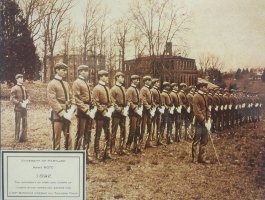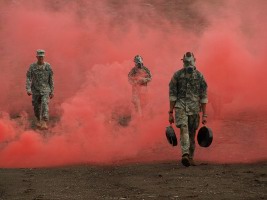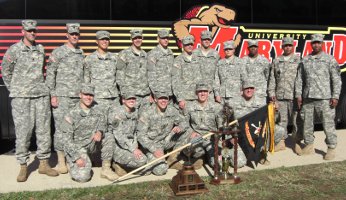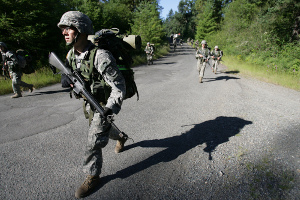About Us
Battalion Profile
 Military
education at the University of Maryland began with the Morrill Land Grant Act of 1862, which required universities
who were receiving federal aid to teach agriculture, mechanical arts, and military tactics. When the university
opened in 1867, students wore uniforms and drilled for short a time each week. With the appointments of two
military officers to President and Professor of Engineering, the military emphasis on campus increased, and
training was increased to two hours a day.
Military
education at the University of Maryland began with the Morrill Land Grant Act of 1862, which required universities
who were receiving federal aid to teach agriculture, mechanical arts, and military tactics. When the university
opened in 1867, students wore uniforms and drilled for short a time each week. With the appointments of two
military officers to President and Professor of Engineering, the military emphasis on campus increased, and
training was increased to two hours a day.
After World War II, the University and the Department of Defense believed that future wars would be fought in the skies with nuclear power, so in 1949 the Army ROTC program left the campus to make room for Air Force ROTC. After 1949, students who wished to participate in Army ROTC had to travel up to 35 miles from campus to attend programs from Johns Hopkins, Georgetown, or Bowie State University. Army ROTC returned to the campus in 2001 as a part of the Georgetown Army ROTC program, and by the 2002-2003 school year had separated completely from Georgetown to form the Terrapin Battalion.
 Since returning to campus in 2001, the Army ROTC program has sent many cadets to
Army Specialty Schools to learn new skills and enhance leadership, such as the Airborne School
and the Air Assault School, and many cadets abroad to enhance cultural understanding and language proficiency.
The program has sent cadets to Greece, Panama, China, Slovakia, Morocco, and other countries through its Cultural
Understanding Language Proficiency Program (CULP), and to Barcelona, Spain through its Study Abroad program.
Cadets from the program have also taken advantage of internship opportunities and the university's close
proximity to Washington D.C., working at the White House, the Department of Homeland Security, the U.S. Senate, and the Secret Service.
Since returning to campus in 2001, the Army ROTC program has sent many cadets to
Army Specialty Schools to learn new skills and enhance leadership, such as the Airborne School
and the Air Assault School, and many cadets abroad to enhance cultural understanding and language proficiency.
The program has sent cadets to Greece, Panama, China, Slovakia, Morocco, and other countries through its Cultural
Understanding Language Proficiency Program (CULP), and to Barcelona, Spain through its Study Abroad program.
Cadets from the program have also taken advantage of internship opportunities and the university's close
proximity to Washington D.C., working at the White House, the Department of Homeland Security, the U.S. Senate, and the Secret Service.
 Cadets in the program annually participate in the Army 10 Miler and compete in the Ranger
Challenge Competition. This program, through the hard work of its cadets, has won its
division in the Ranger Challenge Competition multiple times, and has taken the entire
competition to win the 4th Brigade Ranger Challenge Competition, placing first out of 39 schools.
Cadets in the program annually participate in the Army 10 Miler and compete in the Ranger
Challenge Competition. This program, through the hard work of its cadets, has won its
division in the Ranger Challenge Competition multiple times, and has taken the entire
competition to win the 4th Brigade Ranger Challenge Competition, placing first out of 39 schools.
 Even with busy schedules and difficult training, the cadets are able to maintain a battalion average GPA of 3.2,
and a battalion average Army Physical Fitness Test (APFT) score of 265-269. Additionally, these cadets perform well
at the Leader Development and Assessment Course (LDAC), which all cadets participate in at the end of their junior
year, with 33% of cadets from this program receiving a rating of Excellent, and 18.3% of cadets from this program
placing in the Top 5 since 2005. Because of all these achievements, 87% of cadets receive either their first or
second branch choice when the time comes for these cadets to commission and join the Regular Army.
Even with busy schedules and difficult training, the cadets are able to maintain a battalion average GPA of 3.2,
and a battalion average Army Physical Fitness Test (APFT) score of 265-269. Additionally, these cadets perform well
at the Leader Development and Assessment Course (LDAC), which all cadets participate in at the end of their junior
year, with 33% of cadets from this program receiving a rating of Excellent, and 18.3% of cadets from this program
placing in the Top 5 since 2005. Because of all these achievements, 87% of cadets receive either their first or
second branch choice when the time comes for these cadets to commission and join the Regular Army.
